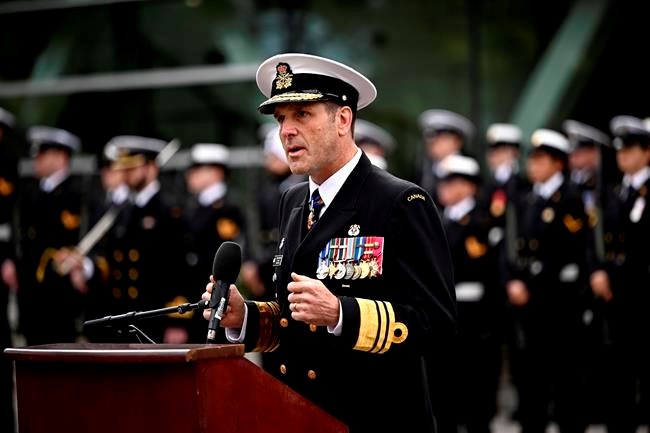OTTAWA — The commander of the Royal Canadian Navy has released a new video warning the force is in a "critical state," with ships that are beyond their life cycle and a severe shortage of sailors to operate them.
In a video posted to the navy's YouTube page, Vice-Admiral Angus Topshee said the force may not meet its readiness commitments next year and beyond, though he tried to strike an optimistic tone about its "very bright" future.
"Historically, we have risen to every challenge, so I am confident we will find a way to get through this," Topshee said in the video.
The video was played at a defence leadership symposium last week, where Topshee also delivered an in-person address.
It was intended "to highlight the (navy's) priorities while providing a fair and honest assessment of the state of Royal Canadian Navy," the Defence Department said in a statement.
The video includes a chart of navy occupations and their current staffing levels, showing that many roles have vacancy rates above 20 per cent.
Topshee said that is because the Canadian Armed Forces recruitment wing has failed to meet its targets for more than 10 years.
He said the air force and army are in similar situations.
The West Coast fleet is suffering, Topshee said, because there's a lack of qualified people to maintain and operate the ships, forcing the navy to prioritize its Halifax class instead.
And a shortage of techs means only one of the new Arctic and offshore patrol ships can be in use at a time, even though four are ready.
He said it will be a challenge to get ready to fully staff the vessels that are currently being built under the National Shipbuilding Strategy.
"The highest priority for the Royal Canadian Navy is attracting, recruiting and training sailors to the occupational functional point to hold our trained effective strength at its current level," Topshee said, adding that the navy may not reach that target this year and will not meet it next year.
The video notes that 98 people are part of a recent pilot project that allows recruits to sign on with the navy for one year, and another 400 are in the recruiting process.
Topshee said that program is also helping to improve the recruitment of Indigenous Peoples and other minorities.
The navy needs to enrol 1,200 new people each year to address its personnel problem, the video said.
The Canadian Armed Forces has said it is short about 16,000 troops in the regular and reserve forces across all branches of the military, and another 10,000 soldiers do not have the training they need to be deployed.
In a memo from October 2022, defence chief Gen. Wayne Eyre ordered a halt to all non-essential activities to focus on boosting recruitment and retention.
More than a year later, Defence Minister Bill Blair told the House defence committee last week that recruitment issues persist.
On Wednesday, the minister acknowledged that the government is asking the Armed Forces to do more at the same time.
"We've got them deployed into the Indo-Pacific, and in both our Norad and NATO responsibilities there are significant challenges, but I think we're up to the challenges," he said.
Blair told reporters there "absolutely" will be enough sailors for Canada's new fleets when they're built, and said militaries and police forces around the world are struggling to recruit.
But Liberal MP John McKay, chair of the House defence committee, did not mince words on Tuesday when he accused media and the Canadian public of not caring enough about the military to make it a priority.
"In the last two years, we've had a dramatic change in the threat environment and we are — on a personnel basis and on an equipment basis — not ready to meet the threat environment," he told reporters outside the weekly Liberal caucus meeting.
"It frustrates me that we have under-invested in defence and development and diplomacy, and in ourselves."
As for equipment, Topshee said the navy must extend the life of its Halifax class ships for at least another 15 years until new surface combatants are ready to take their place.
The first of those ships is expected to be delivered early in the 2030s, but each will require two to three years of trials and testing before it is ready for use.
Keeping the Halifax class at sea until at least 2040, years beyond the 30-year lifespan it has already reached, will be a "very considerable challenge," Topshee said.
This report by The Canadian Press was first published Nov. 29, 2023.
Sarah Ritchie, The Canadian Press



